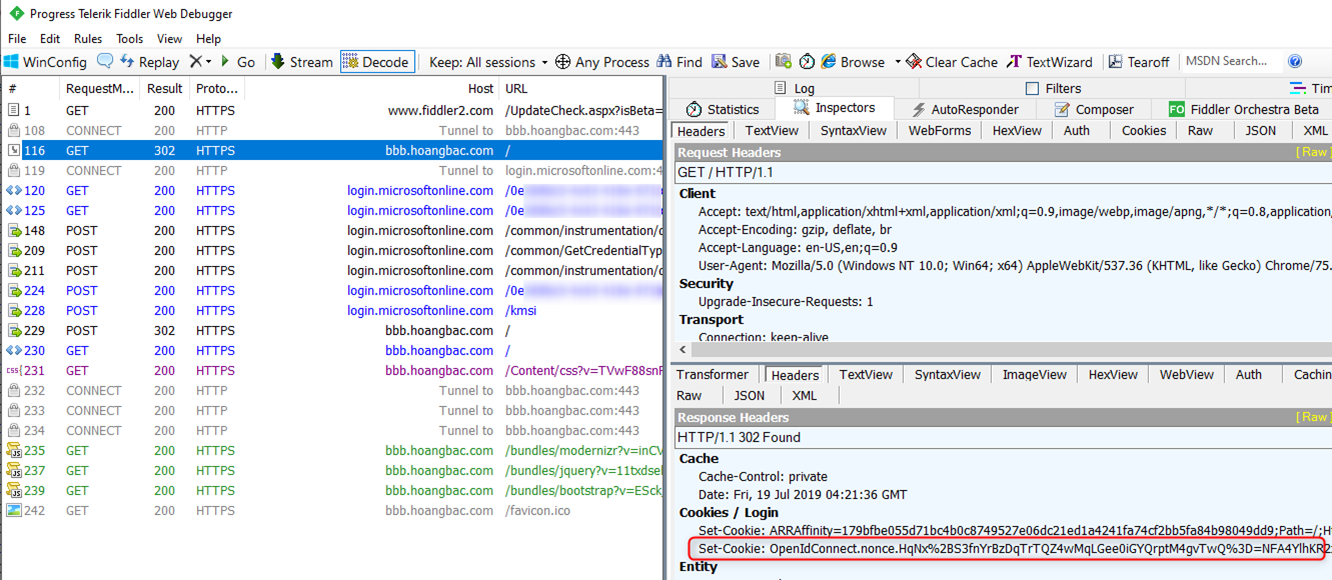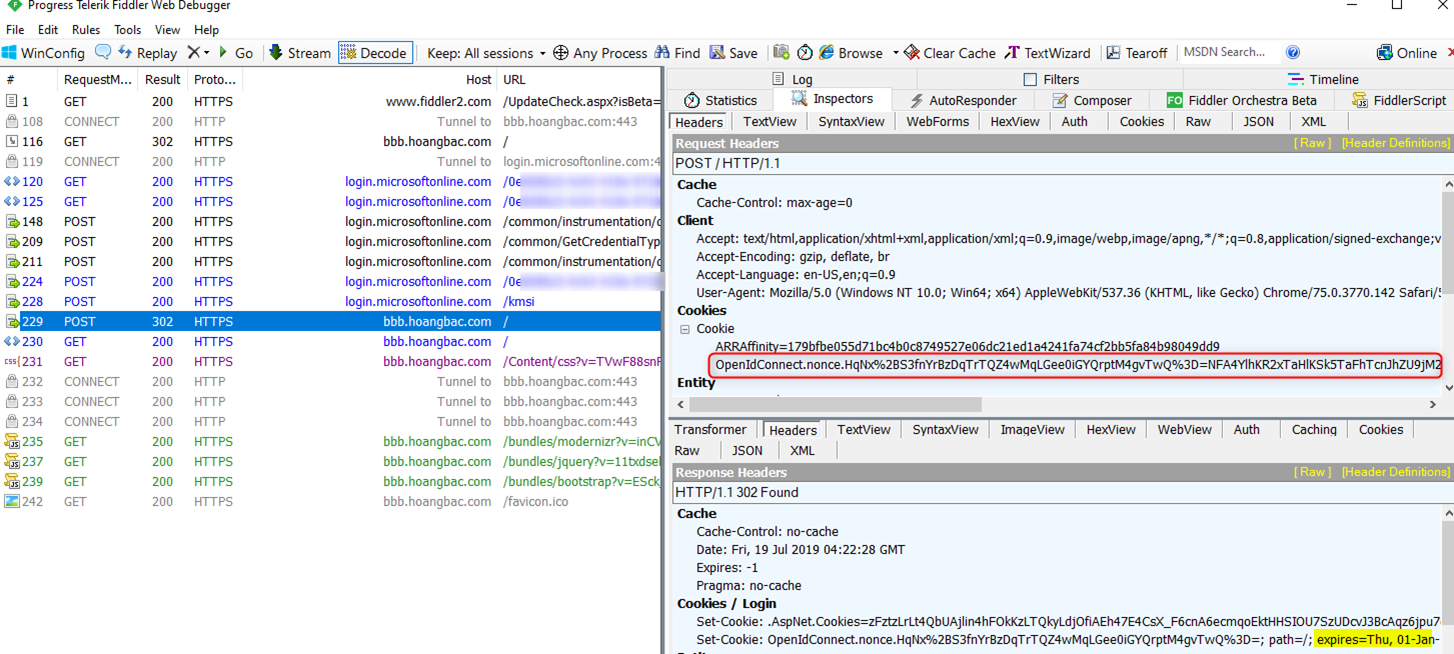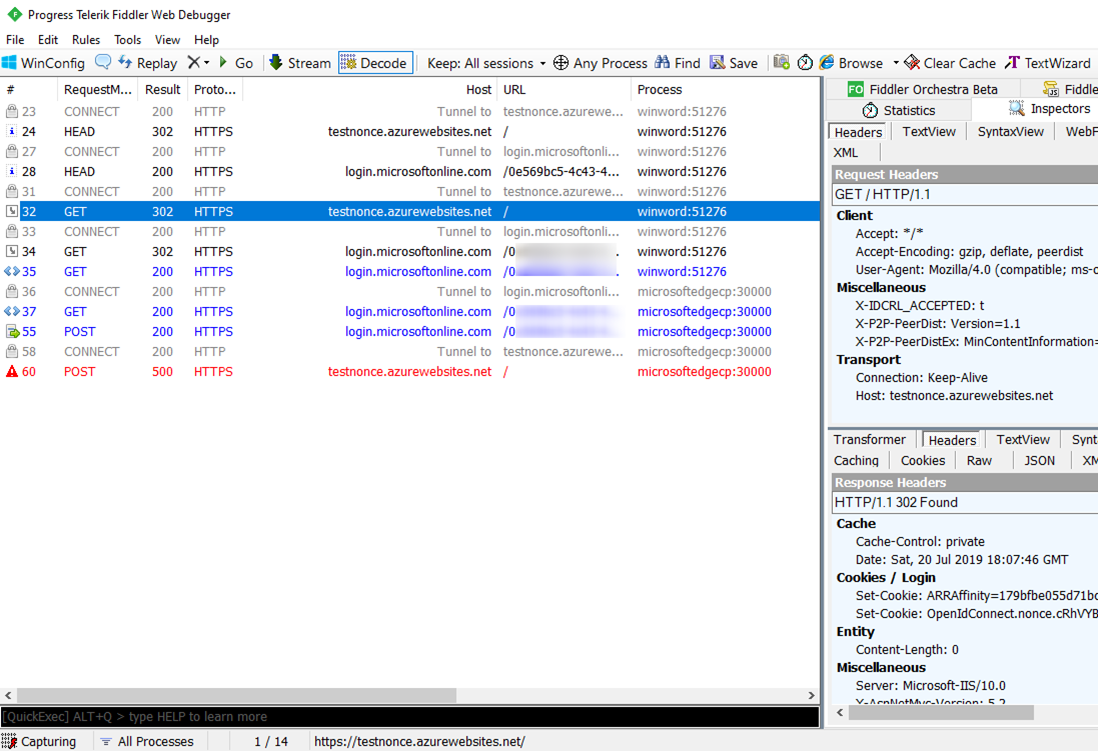Depending on what version of OWIN is used, you may see the following error in an MVC application using OpenID Connect middleware
IDX21323: RequireNonce is ‘[PII is hidden by default. Set the ‘ShowPII’ flag in IdentityModelEventSource.cs to true to reveal it.]’. OpenIdConnectProtocolValidationContext.Nonce was null, OpenIdConnectProtocol.ValidatedIdToken.Payload.Nonce was not null. The nonce cannot be validated. If you don’t need to check the nonce, set OpenIdConnectProtocolValidator.RequireNonce to ‘false’. Note if a ‘nonce’ is found it will be evaluated.
Or
Error: “IDX10311: RequireNonce is ‘true’ (default) but validationContext.Nonce is null. A nonce cannot be validated. If you don’t need to check the nonce, set OpenIdConnectProtocolValidator.RequireNonce to ‘false’.”
Asp.net OpenID Connect (OIDC) middleware uses the nonce cookie to prevent security replay attack. As the error said, the application throws the above exception when it does not see the nonce cookie in the authenticated request. Cookies are domain-based so once they are set for a particular domain all subsequent requests to that domain will contain these cookies as long as they are still valid (haven’t expired or deleted yet).
Before diving into the detail it’s important to understand how these cookies are set and used in a working flow from the following Fiddler trace:
In frame 116 the browser sends a request to the OIDC application protected by Azure AD. The application, upon checking sees that this request is not authenticated so it redirects the request to Azure AD (login.microsoftonline.com) for login. Note that the application also sets the red-circled OpenIdConnect.nonce cookie in the 302 redirect response.
hover over image to enlarge

After successful authentication (frame 120 – 228), Azure AD redirects the request back to the web application (frame 229) with the authenticated id token. The nonce cookie previously set for this domain is also included in the POST request. The OIDC middleware validates the authenticated token and the nonce cookie before it continues loading the page (via another redirect). Note that at this point the purpose of the nonce cookie is complete so it’s invalidated by the application setting the expiration attribute to expire (highlighted).
hover over image to enlarge

How does the above error occur?
There might be multiple reason. Below are a few different scenarios where this error happens.
Multiple Domains are used for the same web site:
The browser originally navigates to the web application on domain A (frame 9 below). The nonce cookie is then set for this domain and then later Azure AD sends the authenticated token to domain B (frame 91). The redirection to domain B doesn’t have any nonce cookie so the web application throws the above error.
hover over image to enlarge

The solution here is to redirect the request back to the same domain used originally after authentication. To control where Azure AD sent the authenticated request back to the application, set the OpenIdConnectAuthentications.RedirectUri property in the ConfigureAuth method below.
Note: the reply URL will also need to be configured in Azure Active Directory’s App Registration, otherwise you may run into this error.
The application is opened from an Office Document
The scenario usually involves the user clicking on a link that opens an Azure AD protected OIDC application in Excel, Word, or any other Office document and they see the error after providing credential. The problem here is that there are multiple processes (Office and browser) involved and they don’t share cookies with each other. In the screen shot below the Word process originally navigates to the web site (frame 24 to frame 35). It then transitions the navigation over to the browser process (starting in frame 36). The nonce cookie is set originally in frame 32 in the word process when the request is redirected to Azure AD for authentication. In frame 60, the request is redirected back to the application in the browser process with an authenticated token and this is where the error occurs since the browser process does not have any nonce cookie.
hover over image to enlarge

This is a known issue due to the way Office handles http binding and how cookies work and has been discussed extensively in the following links. There are also a few proposed workarounds in these links:
https://github.com/aspnet/AspNetKatana/issues/78
https://github.com/aspnet/Security/issues/1252
https://support.microsoft.com/en-us/help/838028/how-documents-are-opened-from-a-web-site-in-office-2003
Below are some ideas to work around this issue:
-
Set the following registry key (on 64 bit OS) on the client machine where browsing is performed to disable hlink binding (see https://social.technet.microsoft.com/Forums/en-US/fe8f827f-a801-4fc0-b820-8dc30f816467/unable-to-hyperlink-to-company-applications-office-2016-proplus for more detail)
[HKEY_LOCAL_MACHINE\SOFTWARE\Wow6432Node\Microsoft\Office\9.0\Common\Internet]
“ForceShellExecute”=dword:00000001 -
Disable nonce cookie checking (not recommended since this has security impact)
app.UseOpenIdConnectAuthentication(
new OpenIdConnectAuthenticationOptions
{
ClientId = clientId,
Authority = authority,
PostLogoutRedirectUri = postLogoutRedirectUri,
ProtocolValidator = new Microsoft.IdentityModel.Protocols.OpenIdConnectProtocolValidator()
{
RequireNonce = false
}
});
- Create a landing page without authentication and then use the landing page to redirect to the real site. Use the landing page to open from Office documents.
-
Perform browser detection in the web application to check for request from Office and return an empty html page as referenced in https://gist.github.com/bachoang/942a8223a689ceba77987b9c3f54ab61
The OpenID Connect Nonce cookie does not have these attributes set: SameSite=None and secure
Due to the recent SameSite cookie security update changes as documented in How to handle SameSite cookie changes in Chrome browser – Microsoft identity platform | Microsoft Docs and in Work with SameSite cookies and the Open Web Interface for .NET (OWIN) | Microsoft Docs, cookies involved in the authentication process, including the Nonce cookies, should have both of these attributes set: SameSite=None and secure. Cookies not having both of these attributes may get dropped by the browser, which will result in the above error. Here is what a Fiddler trace of a working scenario should look like for the request before redirecting to Azure AD for login showing how the Nonce cookie is set:

To make sure both of the above requirements are satisfied you should
- use https protocol to navigate to the web application and
- For .Net application, update the .Net framework to version 4.7.2 or greater and these nuget packages – Microsoft.Owin.Security.OpenIdConnect and Microsoft.Owin to version 4.1.0 or greater. For .Net Core applications, update the .Net Core framework to version 2.1 or greater for .Net Core v2 apps and .Net Core 3.1 for .Net Core v3 apps.
With the above configuration, here is my working code for Startup.Auth.cs
using System.Configuration;
using Owin;
using Microsoft.Owin.Security;
using Microsoft.Owin.Security.Cookies;
using Microsoft.Owin.Security.OpenIdConnect;
using System.Threading.Tasks;
using Microsoft.Owin.Security.Notifications;
using Microsoft.IdentityModel.Protocols.OpenIdConnect;
namespace NetWebAppOIDC2
{
public partial class Startup
{
private static string clientId = ConfigurationManager.AppSettings["ida:ClientId"];
private static string aadInstance = ConfigurationManager.AppSettings["ida:AADInstance"];
private static string tenantId = ConfigurationManager.AppSettings["ida:TenantId"];
private static string postLogoutRedirectUri = ConfigurationManager.AppSettings["ida:PostLogoutRedirectUri"];
private static string authority = aadInstance + tenantId;
public void ConfigureAuth(IAppBuilder app)
{
app.SetDefaultSignInAsAuthenticationType(CookieAuthenticationDefaults.AuthenticationType);
app.UseCookieAuthentication(new CookieAuthenticationOptions());
app.UseOpenIdConnectAuthentication(
new OpenIdConnectAuthenticationOptions
{
ClientId = clientId,
Authority = authority,
PostLogoutRedirectUri = postLogoutRedirectUri,
RedirectUri = "https://localhost:44313",
Notifications = new OpenIdConnectAuthenticationNotifications
{
AuthenticationFailed = OnAuthenticationFailed
}
// Don't use SystemwebCookieManager class here to override the default CookieManager as that seems to negate the SameSite cookie attribute being set
// CookieManager = new SystemWebCookieManager()
});
}
private Task OnAuthenticationFailed(AuthenticationFailedNotification<OpenIdConnectMessage, OpenIdConnectAuthenticationOptions> context)
{
context.HandleResponse();
context.Response.Redirect("/?errormessage=" + context.Exception.Message);
return Task.FromResult(0);
}
}
}
1. Click on ‘Sign in with Microsoft’ for a site
2. wait for certain time
3. enter email address and password
4. show error message like this
IDX21323: RequireNonce is ‘[PII is hidden]’. OpenIdConnectProtocolValidationContext.Nonce was null, OpenIdConnectProtocol.ValidatedIdToken.Payload.Nonce was not null. The nonce cannot be validated. If you don’t need to check the nonce, set OpenIdConnectProtocolValidator.RequireNonce to ‘false’. Note if a ‘nonce’ is found it will be evaluated.
please give me a solution….
Hi Prabhakaran,
The way to understand how this problem occurs is to capture a Fiddler trace. Do you see the nonce cookie being sent to your application?
When I tried error, it produces different error.
IDX21329: RequireState is ‘[PII is hidden]’ but the OpenIdConnectProtocolValidationContext.State is null. State cannot be validated.
I tried following, but same error:
ProtocolValidator = new OpenIdConnectProtocolValidator() {
RequireNonce = false,
RequireState = false
}
See if the issue discussed at https://github.com/aspnet/Security/issues/1557 helps or not. If not, it’s probably better if you open a support case with us.
This resolves it for me:
public void ConfigureAuth(IAppBuilder app) { app.UseKentorOwinCookieSaver(PipelineStage.Authenticate); //overcome occasional dropped cookies (Katana bug) which cause an exception to be thrown ...Thanks for sharing your code snippet. Do you have any insight on why this nonce cookies were dropped in your case?
I’m getting the IDX21323 error. I’ve checked the network trace and the nonce cookie is being set on reaching the site. I can also see it after authentication, and then it’s set to expire. I’m not using multiple domains for the same site, and my RedirectUri is set to the domain the cookie is created on. The same address has been added to reply URLs in AAD, and the application is also not opened from an Office document.
I can’t see that it’s actually causing users any problems, but it would be nice if the exception didn’t occur. Is there anything else I can do or check? Thanks
Do you see anything that might give a hint in the Browser Developer Tools console? Does this happen on all browsers or only certain browsers? This may require more in depth investigation. Can you open a support case with us to look at this in greater detail?
I’ve done some more testing and I’ve found that on the rare occasion the nonce cookie in the POST request after authentication is different to the one that’s created originally. The response header does show the original cookie being set to expire though. There doesn’t seem to be any pattern to when this happens, and it can occur in any browser.
Take a look at https://blogs.aaddevsup.xyz/2019/11/infinite-sign-in-loop-between-mvc-application-and-azure-ad/ to make sure you are not running into this Katana bug.
Also due to recent change regarding cookies SameSite attribute as documented here, cookies (including OpenID Connect nonce cookies) that have SameSite=none will also require secure attribute to be set. Whether this secure attribute is set or not depends on the original website navigation. The secure attribute is only set if the original web site navigation happens with https. Due to this security restriction you can encounter this error if you use http to browse to the site originally and then use https as a redirect URL. Make sure all your web site navigation use https.
Facing same issue any possible solution?
This blog provided 2 scenarios with solution. If it still does not help, it may be best to open a support case with us.
Hi,
I am running into a problem wherein my ASP.NET application enters into redirect loop upon successful authentication from Azure AD. what exactly making it to go into loop and how to solve it, any suggestion will be greatly appreciated. I am Using openidconnect v3.1. Nonce is true in my case
See if any of the following helps. If not, it’s best to open a support case with us
https://blogs.aaddevsup.xyz/2019/07/infinite-redirect-between-openid-connect-application-and-azure-ad/
https://blogs.aaddevsup.xyz/2019/11/infinite-sign-in-loop-between-mvc-application-and-azure-ad/
Hi Bac,
Thank you for you timely reply .
I have tried the 2nd approach where in i have changed the redirecturi in AuthenticationProperty class to the root of the application and is kind of working now and I am able to login to my application without any redirect loop with SameSite=Strict attribute to the cookies. not sure why it is working if you have any insight please enlighten us. Once again Thank you.
When dealing with authentication it’s recommended to set samesite=none and secure attributes on authentication-related cookies for optimal result